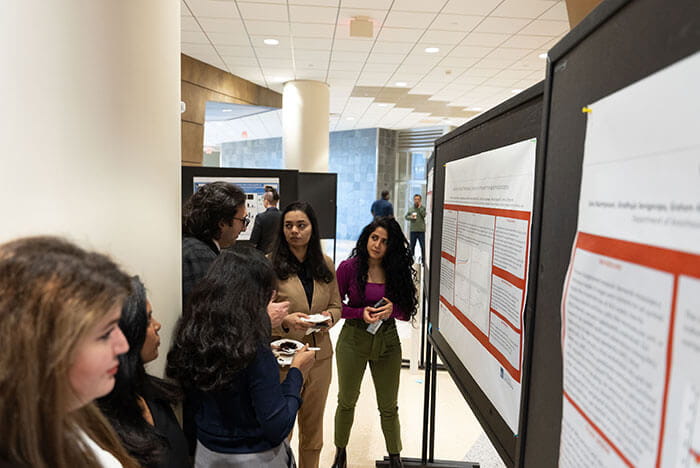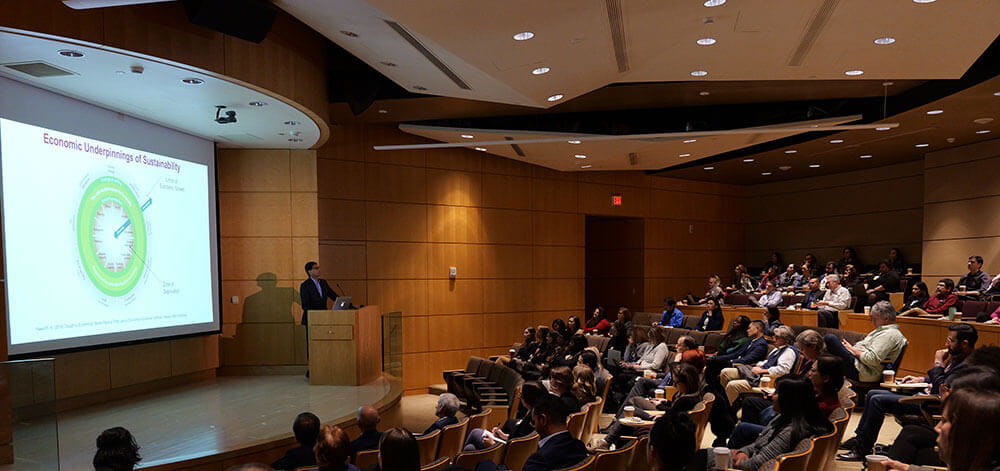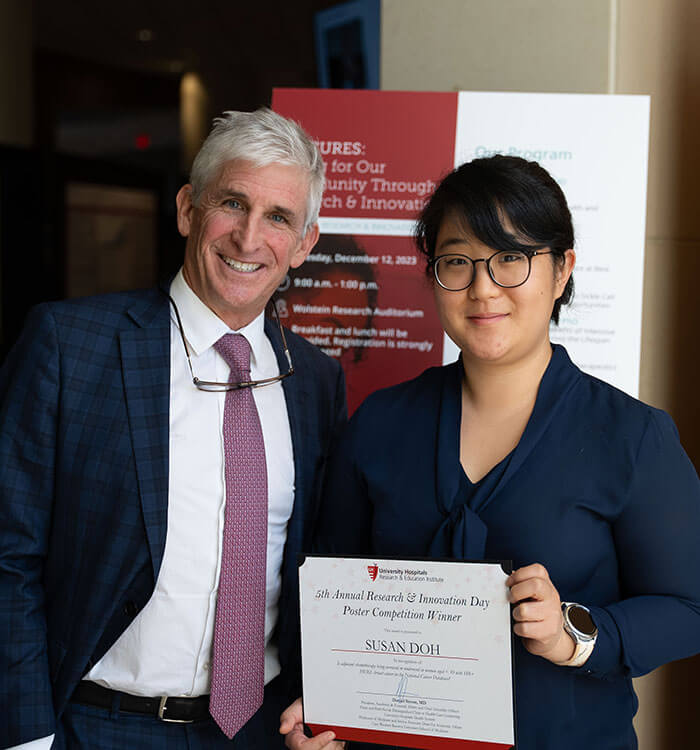5th UH Research & Innovation Day Highlights Research Growth, Promotes Team Science and Explores Sustainable Solutions for Complex Problems
February 25, 2024
UH Research & Education Update | February 2024
Discovery and innovation are at the heart of tomorrow’s cures. They are essential to the delivery of highly advanced medical treatments and power the most efficient and effective healthcare organizations.
Throughout the health system, there are limitless opportunities to widen the realm of what is possible in medicine today in an environment where the pace of research and innovation is accelerating like never before. In fact, our total research funding reached nearly $200 million in 2023, up from $177 million the previous year, according to Daniel Simon, MD, President, Academic & External Affairs and Chief Scientific Officer, and the Ernie and Patti Novak Distinguished Chair in Health Care Leadership for University Hospitals.
The proximity of our clinicians and researchers working alongside one another and in collaboration with experts across their fields provides rich and fertile ground for accelerating the development of new treatments from bench to bedside to population health. Throughout our organization, key discoveries and continued medical advances enable us to provide patients with the latest drug, device and cell-based therapeutics that are only available in clinical trials.
It was against this exciting backdrop that the UH Research & Education Institute hosted its fifth annual Research & Innovation Day to highlight transformative research underway at University Hospitals and to encourage researchers to take advantage of the resources we have in place to support science, discovery, and the commercialization of promising lab and clinical developments.
Research & Innovation Day Showcases Research Success
 5th Annual UH Research & Innovation Day poster session.
5th Annual UH Research & Innovation Day poster session.First held in 2019, Research & Innovation Day has a history of bringing together the UH community and prominent scientists to present ideas, research discoveries, and innovations, and this year’s symposium was no exception. The 2023 theme was “UH Cures: Caring for Our Community Through Research and Innovation.”
The half-day symposium featured compelling research findings from faculty including, Dr. Grace McComsey, Dr. Jignesh Dalal, Dr. Rose Gubitosi-Klug, Dr. Quintin Pan and Dr. Amitabh Chak. A thought-provoking keynote address titled “The Critical Importance of Sustainability Thinking in Health and Healthcare,” was delivered by Sanjay Rajagopalan, MD, Chief, Cardiovascular Medicine and Chief Academic and Scientific Officer, University Hospitals Harrington Heart and Vascular Institute.
 Keynote Speaker Sanjay Rajagopalan, MD presenting during the 5th Annual Research & Innovation Day.
Keynote Speaker Sanjay Rajagopalan, MD presenting during the 5th Annual Research & Innovation Day.The event drew an audience of nearly 300 attendees. Participating researchers submitted a record of 65 abstracts presented as posters at the Wolstein Research Building. The highest-scored abstract author, Reine Abou Zeidane, MD, was selected to present her work in the symposium.
 Dan Simon, MD and Susan Doh, 2nd year UH Resident and poster competition winner.
Dan Simon, MD and Susan Doh, 2nd year UH Resident and poster competition winner.“Nothing makes me prouder than seeing trainees share their science,” Dr. Simon said in his welcome remarks. It was “Just a tremendous group of posters across the full spectrum of basic, translational, clinical, and health services research.”
Activities like the annual symposium elevate the reputation of University Hospitals as an academic medical center that enhances patient care and the well-being of our community through expansive research efforts. They also encourage individuals to be more mindful of opportunities to engage in research projects, based on their expertise clinical and scientific observations, and professional experiences.
Multidisciplinary Teams Drive High-Quality, Productive Research
During the program, speakers emphasized the value of team research, the strength of multi-disciplinary scientific collaborations, and the mounting opportunities to develop sustainable solutions to complex health and health systems issues. Indeed, healthcare innovation requires teams of physicians and scientists with diverse expertise within interdisciplinary research groups to drive the development of new clinical approaches, novel drug therapies, and groundbreaking devices. In the long run, team science has the potential to draw large grants to fuel more sustainable and productive research endeavors with key collaborators and strategic partners.
The high impact of big-team science was the core message by Grace McComsey, MD, Vice President of Research and Associate Chief Scientific Officer for University Hospitals, and Director and Principal Investigator of the Case Western Reserve University Clinical & Translational Science Collaborative of Northern Ohio (CTSC).
Dr. McComsey shared that her career has thrived upon research collaborations. As a young HIV researcher, she learned that “team science is a collaborative effort to address a scientific challenge.” However, she says collaborative research groups must comprise experts with different strengths and expertise. She also advises that researchers lead at least some studies in collaborative groups. “I’m not saying you have to be a leader in every study, that’s not good, but to learn all aspects of research, including how to lead team science,” she explained.
Dr. McComsey emphasized the tremendous collaboration in securing the $56.3 million grant from the National Institutes of Health that renews CTSC to support and accelerate biomedical research and innovation throughout Northern Ohio. She visualizes greater use of the CTSC by University Hospitals to maximize opportunities for multi-center studies. The CTSC houses a wealth of resources to help improve the research process, assist with recruiting underrepresented populations and offer training, education, mentorship, and funding options to propel research forward.
Team Science is Vital in Addressing Future Disease Prevention and Treatment Needs
In his keynote address on the importance of sustainability thinking in health and healthcare, Dr. Rajagopalan noted a shift to a systems view of health and disease over the last 50-60 years from a previous approach that considered simple, common disease factors. The change in perspective has widened the scope of research and medicine today, intersecting with other industries and fueling greater opportunities for multi-disciplinary team research.
“We find health to be ensconced in a much larger macrocosm than what we recognize to be causative of disease, and that includes the environment you live in, societal influences, the economy,” and other social determinants of health,” Dr. Rajagopalan said. “The truth is these factors interact (and result in) complex disease phenotypes. This is particularly the case for chronic non-communicable diseases for which you take into account for multiple factors,” he said.
For instance, cancer and cardiovascular disease are much more complex. Clinicians and scientists must consider a many factors to understand disease and develop holistic solutions. Consequently, “A tremendous amount of team science will be required around the world to address social, economic and environmental factors that adversely affect health,” Dr. Rajagopalan said.


